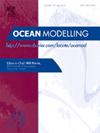流体力学中的傅里叶极限,并与湍流联系起来
IF 2.9
3区 地球科学
Q2 METEOROLOGY & ATMOSPHERIC SCIENCES
引用次数: 0
摘要
宏观流体被认为是连续的,直到微观尺度,在微观尺度上,它们的密度不足以使单独的粒子在这个尺度上有足够多的碰撞(相互作用)。我们认为,由波数k定义的傅里叶空间中的特征流体长度尺度也有类似的限制。在Δkk≪1处,傅里叶空间不能被认为是连续的,在这些尺度上,能量密度谱变得离散。我们进一步注意到,在物理空间中,粒子中心之间的距离不能比它们的直径更近,并且在这个体积内,物理力具有完全不同的性质。类似地,如果波模式的波数比傅里叶空间中的阈值更接近,则可以预期非常不同的相互作用。认为波数空间Δkk<;1/400可以看作是波模k的傅里叶体积。本文假设该傅里叶体积中充满了背景种子湍流,就像物理空间中固体粒子的体积充满了物质一样。离散波谱中模态间的波能并不缺失,它是背景湍流的能量,类似于运动的固体粒子分子的内能。这种湍流种子能量约为本文所讨论的邻近波模能量的0.1% %,并且它可能因不稳定性而增长。单向流可以看作是波长是平均速度定义动能的现象的两倍的半波,其中动能的一部分流向了种子湍流。该流的深度(横长)不是一个独立的属性,而是与长度和速度尺度的平方之比成正比。在存在表面的情况下,该深度垂直于表面,并定义了边界层的长度尺度。本文章由计算机程序翻译,如有差异,请以英文原文为准。
Fourier limit in fluid mechanics, and link to the turbulence
Macroscopic fluids are considered continuous down to microscopic scales where they fail to be dense enough for separate particles to have sufficiently large number of collisions (interactions) over that scale. We argue that a similar limit applies to the characteristic fluid length scales in the Fourier space, defined by wavenumber k. At , the Fourier space cannot be regarded continuous, and at these scales the energy-density spectrum becomes discrete. We further note that in physical space, the particle centres cannot come closer to each other than their diameter, and within this volume the physical forces are of a completely different nature. Similarly, very different interactions can be expected if wave modes have wavenumbers closer than a threshold in the Fourier space. It is argued that the wavenumber space can be considered as a Fourier volume of wave mode k. It is the hypothesis of this paper that this volume of the Fourier modes is filled with background seed turbulence, - like the volume of solid particles in the physical space is filled with the matter. The wave energy between modes in the discrete wave spectrum is not missing, it is the energy of background turbulence, like internal energy of molecules of the moving solid particle. This turbulence seed energy is about 0.1 % of the energy of neighbouring wave modes as argued in this paper, and it can grow subject to instabilities. The unidirectional flow can be treated as a half-wave with wavelength twice the size of the phenomenon where the mean velocity defines kinetic energy, part of which goes to the seed turbulence. The depth (cross-length) of this flow is not an independent property and is proportional to ratio of the length and velocity scales all squared. In case of surface present, this depth is perpendicular to the surface and defines the length scale of the boundary layer.
求助全文
通过发布文献求助,成功后即可免费获取论文全文。
去求助
来源期刊

Ocean Modelling
地学-海洋学
CiteScore
5.50
自引率
9.40%
发文量
86
审稿时长
19.6 weeks
期刊介绍:
The main objective of Ocean Modelling is to provide rapid communication between those interested in ocean modelling, whether through direct observation, or through analytical, numerical or laboratory models, and including interactions between physical and biogeochemical or biological phenomena. Because of the intimate links between ocean and atmosphere, involvement of scientists interested in influences of either medium on the other is welcome. The journal has a wide scope and includes ocean-atmosphere interaction in various forms as well as pure ocean results. In addition to primary peer-reviewed papers, the journal provides review papers, preliminary communications, and discussions.
 求助内容:
求助内容: 应助结果提醒方式:
应助结果提醒方式:


